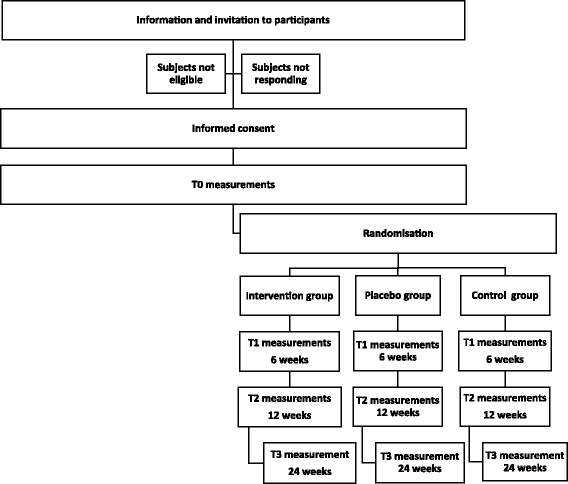Design of a randomized controlled trial on the effect on return to work with coaching plus light therapy and pulsed electromagnetic field therapy for workers with work-related chronic stress
- PMID: 27430621
- PMCID: PMC4950115
- DOI: 10.1186/s12889-016-3276-6
Design of a randomized controlled trial on the effect on return to work with coaching plus light therapy and pulsed electromagnetic field therapy for workers with work-related chronic stress
Abstract
Background: Work-related chronic stress is a common problem among workers. The core complaint is that the employee feels exhausted, which has an effect on the well-being and functioning of the employee, and an impact on the employer and society. The employee's absence is costly due to lost productivity and medical expenses. The usual form of care for work-related chronic stress is coaching, using a cognitive-behavioural approach whose primary aim is to reduce symptoms and improve functioning. Light therapy and pulsed electromagnetic field therapy are used for the treatment of several mental and physical disorders. The objective of this study is to determine whether coaching combined with light therapy plus pulsed electromagnetic field therapy is an effective treatment for reducing absenteeism, fatigue and stress, and improving quality of life compared to coaching alone.
Methods/design: The randomized placebo-controlled trial consists of three arms. The population consists of 90 participants with work-related chronic stress complaints. The research groups are: (i) intervention group; (ii) placebo group; and (iii) control group. Participants in the intervention group will be treated with light therapy/pulsed electromagnetic field therapy for 12 weeks, twice a week for 40 min, and coaching (once a fortnight for 50 min). The placebo group receives the same treatment but with the light and pulsed electromagnetic field switched to placebo settings. The control group receives only coaching for 12 weeks, a course of six sessions, once a fortnight for 50 min. The primary outcome is the level of return to work. Secondary outcomes are fatigue, stress and quality of life. Outcomes will be measured at baseline, 6 weeks, 12 and 24 weeks after start of treatment.
Discussion: This study will provide information about the effectiveness of coaching and light therapy plus pulsed electromagnetic field therapy on return to work, and secondly on fatigue, stress and quality of life in people with work-related chronic stress.
Trial registration: NTR4794 , registration date 18-sept-2014.
Keywords: Burnout; Fatigue; Light therapy; Pulsed electromagnetic field therapy (PEMF); Quality of life; Stress; Work participation; Work-related chronic stress.
Figures
Similar articles
-
Evaluation of a randomized controlled trial on the effect on return to work with coaching combined with light therapy and pulsed electromagnetic field therapy for workers with work-related chronic stress.BMC Public Health. 2017 Oct 2;17(1):761. doi: 10.1186/s12889-017-4720-y. BMC Public Health. 2017. PMID: 28969697 Free PMC article. Clinical Trial.
-
Integrated mental health care and vocational rehabilitation to improve return to work rates for people on sick leave because of exhaustion disorder, adjustment disorder, and distress (the Danish IBBIS trial): study protocol for a randomized controlled trial.Trials. 2017 Dec 2;18(1):579. doi: 10.1186/s13063-017-2273-0. Trials. 2017. PMID: 29197404 Free PMC article. Clinical Trial.
-
Effects of a pulsed electromagnetic therapy on multiple sclerosis fatigue and quality of life: a double-blind, placebo controlled trial.Altern Ther Health Med. 2003 Jul-Aug;9(4):38-48. Altern Ther Health Med. 2003. PMID: 12868251 Clinical Trial.
-
Novel Augmentation Strategies in Major Depression.Dan Med J. 2017 Apr;64(4):B5338. Dan Med J. 2017. PMID: 28385173 Review.
-
Mindfulness and bodily distress.Dan Med J. 2012 Nov;59(11):B4547. Dan Med J. 2012. PMID: 23171754 Review.
Cited by
-
Evaluation of a randomized controlled trial on the effect on return to work with coaching combined with light therapy and pulsed electromagnetic field therapy for workers with work-related chronic stress.BMC Public Health. 2017 Oct 2;17(1):761. doi: 10.1186/s12889-017-4720-y. BMC Public Health. 2017. PMID: 28969697 Free PMC article. Clinical Trial.
References
-
- Schaufeli WB, Maslach C, Marek T. Historical and conceptual development of burnout. 1993. pp. 1–16.
-
- Sluiter JK, de Groene G, Nieuwenhuizen K. Burnout als beroepsziekte [burnout as an occupational disease] Tijdschrift voor Arbeidsvraagstukken. 2013;19(2):279–286.
-
- Schaufeli WB, Bakker AB. De psychologie van arbeid en gezondheid [the psychology of work and health] Houten: Bohn Stafleu Van Loghum; 2007.
-
- Schaufeli WB, Leiter MP, Maslach C. Burnout: thirty-five years of research and practice. Career Dev Int. 2009;14:204–220. doi: 10.1108/13620430910966406. - DOI
Publication types
MeSH terms
Associated data
LinkOut - more resources
Full Text Sources
Other Literature Sources
Medical



